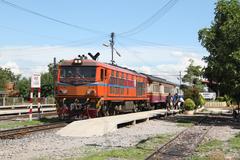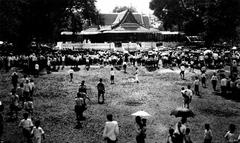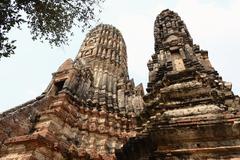
Complete Visitor Guide to Wat Phra Sri Sanphet in Phra Nakhon Si Ayutthaya, Thailand (2025)
Date: 03/07/2025
Introduction: Historical and Cultural Significance
Wat Phra Sri Sanphet is one of Ayutthaya’s most iconic monuments, renowned for its grand chedis, royal legacy, and architectural beauty. Originally built in the 14th century on the grounds of the kingdom’s first royal palace, it became the exclusive royal chapel, reserved solely for the monarchy and serving as the spiritual heart of Ayutthaya. The three striking bell-shaped chedis, which enshrine the ashes of revered Ayutthaya kings, stand as enduring symbols of the city’s golden era and its intertwining of political and religious authority. Today, the site is a centerpiece of the UNESCO-listed Ayutthaya Historical Park, inviting visitors to explore Thailand’s royal heritage and Buddhist traditions amid evocative ruins and lush grounds (Wikipedia; Thailand For Visitors; Nomads Travel Guide).
Table of Contents
- Introduction
- History and Royal Origins
- Architectural Highlights
- Religious and Political Role
- Decline, Destruction, and Restoration
- Visiting Information
- Frequently Asked Questions (FAQ)
- Visuals & Media Suggestions
- Summary & Call to Action
- References
History and Royal Origins
In 1350, King U-Thong (Ramathibodi I) founded Ayutthaya and established his royal palace on the site of present-day Wat Phra Sri Sanphet (Wikipedia; Renown-Travel). For nearly a century, the area served as royal residence. In 1448, King Borommatrailokkanat moved the palace north and converted the original site into a royal monastery, laying the foundation for what would become the most important temple of Ayutthaya (Sawadiscovery; Thaiunika Travel).
Architectural Highlights
The Chedis
The temple is famous for its three large bell-shaped chedis, constructed to house the ashes of King Borommatrailokkanat, King Borommaracha III, and King Ramathibodi II. These chedis, aligned on an elevated terrace, dominate the skyline and are a classic example of Ayutthaya’s late-period architecture (Thailandee.com).
- Design: Combining Sri Lankan and Thai influences, the chedis have high square bases, steep steps, and lotus-bud finials.
- Materials: Brick cores covered in stucco, with remains of gold leaf attesting to their former splendor.
Auxiliary Structures
Other notable ruins include the foundations of the grand viharn (assembly hall), once home to a 16-meter-tall gold-covered Buddha image, as well as smaller chedis, mondops (pavilions), and galleries lined with Buddha images (The Sunrise Dreamers). Ornamental stucco reliefs and lotus motifs are visible in fragments throughout the site.
Layout
The rectangular temple compound, set within the old palace walls, reflects both cosmological symbolism and royal exclusivity. The chedis’ placement along an east-west axis emphasizes the temple’s spiritual and ceremonial purpose.
Religious and Political Role
Wat Phra Sri Sanphet served as the exclusive royal chapel. No monks lived here; instead, it was the stage for major state ceremonies—coronations, royal merit-making, and oath-taking—reinforcing the king’s dual role as political and spiritual leader. The burial of royal ashes within the chedis created a sacred dynastic mausoleum, underscoring the temple’s function as a symbol of continuity and legitimacy (North of Known; Thailand For Visitors; Journalia.blog).
Decline, Destruction, and Restoration
The Burmese army sacked Ayutthaya in 1767, destroying much of Wat Phra Sri Sanphet. The famed golden Buddha was melted down, and the temple was left in ruins (Wikipedia; Renown-Travel). The site remained abandoned for nearly two centuries.
Restoration began in the 20th century, with major conservation by Thailand’s Fine Arts Department in the 1950s. In 1991, Ayutthaya Historical Park—including Wat Phra Sri Sanphet—was designated a UNESCO World Heritage Site, ensuring its preservation and global recognition (North of Known; Voyage Tips).
Visiting Information
Hours & Tickets
- Opening Hours: Daily, 8:00 AM – 6:00 PM (some sources note 7:00 AM – 6:00 PM; check locally for updates).
- Admission: 50 THB for foreign adults; free for Thai nationals and children under 15 (Nomads Travel Guide; Best Price Travel).
Getting There
Wat Phra Sri Sanphet is centrally located in Ayutthaya Historical Park, about 80 km north of Bangkok. Access options include train, minivan, or bus to Ayutthaya, followed by tuk-tuk, taxi, or bicycle to the site. Bicycles and tuk-tuks are popular for exploring multiple sites (Best Price Travel).
Accessibility
Main pathways are relatively accessible, but uneven ground and steps may challenge those with mobility issues. Some areas may require assistance or are not wheelchair-friendly.
Guided Tours & Tips
- Guided tours: Available via local operators or at the park; highly recommended for in-depth historical context (Indochina Odyssey Tours).
- Self-guided options: Audio guides and brochures are sometimes available.
- Best times to visit: Early morning or late afternoon for cooler temperatures, softer light, and fewer crowds.
- Dress code: Modest clothing (shoulders and knees covered).
- Other tips: Bring water, sun protection, and comfortable shoes; respect all safety barriers and do not climb on the ruins.
Nearby Attractions
- Wat Mahathat: Famous for the Buddha head entwined in tree roots.
- Wat Ratchaburana: Known for its impressive prang and crypt murals.
- Wat Lokayasutharam: Features a giant reclining Buddha.
- Chao Sam Phraya National Museum: Displays artifacts from Ayutthaya’s temples (Trip.com).
Frequently Asked Questions (FAQ)
Q: What are the visiting hours?
A: Daily, 8:00 AM to 6:00 PM (confirm locally for any changes).
Q: How much is admission?
A: 50 THB for foreign adults; free for Thai nationals and children under 15.
Q: Is the site wheelchair accessible?
A: Some main paths are accessible, but uneven ground and steps may limit access.
Q: Are guided tours available?
A: Yes, both group and private tours are available, as well as audio guides.
Q: What is the best time to visit?
A: November to March (dry season); early morning or late afternoon for the best light and fewer crowds.
Q: Can I buy tickets online?
A: Tickets are generally purchased at the entrance; online options are limited.
Visuals & Media Suggestions
- Photo of the three iconic chedis at sunrise or sunset (alt: “Wat Phra Sri Sanphet three chedis at sunrise”)
- Interior view of viharn ruins (alt: “Ruins of the viharn at Wat Phra Sri Sanphet”)
- Map showing the temple’s location within Ayutthaya Historical Park
Summary & Call to Action
Wat Phra Sri Sanphet is a cornerstone of Thailand’s cultural identity, embodying the grandeur of the Ayutthaya Kingdom. Its royal origins, iconic architecture, and enduring spiritual resonance make it a must-visit site. Plan your visit by checking current hours and ticketing, dress respectfully, and consider a guided tour for deeper insight. For a richer Ayutthaya experience, explore nearby temples and museums.
Stay updated with the latest visitor information, tips, and events by downloading the Audiala app and following our social media. For more in-depth guides, check out our related articles on Ayutthaya’s historical sites.
References
- Wat Phra Si Sanphet (Wikipedia)
- Renown-Travel Guide
- Thailand For Visitors
- Nomads Travel Guide
- The Sunrise Dreamers
- Thailandee.com
- Journalia.blog
- Best Price Travel
- Sawadiscovery
- Thaiunika Travel
- North of Known
- CyArk
- Trip.com
- Indochina Odyssey Tours
- Voyage Tips
- The Tourist Checklist
- Hanoi Voyage













































